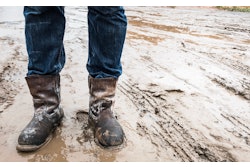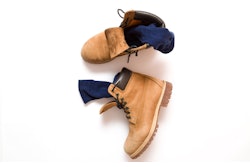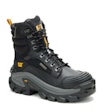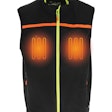
There are several factors to consider when choosing between cotton or wool socks for construction work. Among those factors is moisture-wicking abilities and breathability. Comfort, insulation and temperature regulation, and odor control are other deciding factors.
The time of year also helps dictate the choice of whether to wear wool or cotton socks. Wool offers better insulation and comfort during the colder seasons, while cotton socks can keep feet cooler in the warm weather.
When to Wear Cotton Socks
The upside of wearing cotton socks is that they are soft and comfortable. Cotton socks are breathable and absorb moisture, but in retaining moisture, they can become damp and lead to problems when engaging in long periods of intense work. Cotton socks are best suited for warm weather conditions in terms of insulation and temperature regulation. They may retain odor-causing bacteria and become odorous after prolonged use.
Compared to wool socks, cotton socks are less durable and may wear out more quickly on the job. As previously reported in this IRONPROS story, medical professionals believe cotton socks should be avoided in favor of wool for construction apparel.
Merino Wool Socks
In general, wool socks are good at wicking away moisture and provide breathability. Wool socks offer significant insulation, keeping feet warm during the coldest times of the year. They are considered comfortable and provide additional cushioning and support.
With more durability than cotton, wool socks are able to withstand the wear and tear that can occur with apparel worn during tough construction work. Wool has natural antimicrobial properties that help control odor and keep feet fresher for longer periods of time.
As noted by Elizabeth Scheiber, DPM, Department of Orthopaedic Surgery, Cleveland Clinic Weston (Florida) Hospital, working in construction usually means wearing heavy, non-breathable boots/shoes and or steel toed or composite boots, which cause feet to sweat, which can lead to discomfort, injuries, and infections. Wet socks can lead to fungal infections and thus a choice of socks should take that into account.
Among her recommendations is antimicrobial Merino wool or small fiber wool.
Merino wool is made from the fleece of Merino sheep, which are found primarily in New Zealand and Australia and bears soft and fine wool. That is one factor that sets it apart from other types of wool. Yet despite its fine fibers, Merino wool provides optimal insulation and helps regulate body temperature throughout varying weather conditions. As such, it keeps the person wearing it warm in cold weather and remains breathable, preventing overheating.
Merino wool has the ability to absorb and retain almost up to a third of its weight in moisture, yet still feels dry to the touch. This moisture-wicking ability keeps dry the feet of those wearing Merino wool socks.
Benefits of Merino Wool Socks
The natural antibacterial properties of Merino wool helps to prevent the growth of odor-causing bacteria – a plus for construction workers putting in long, hard days at the job. Merino wool has been found to be well tolerated by those with sensitive skin and wool allergies.
Other properties of Merino wool for which it is favored include it being environmentally-friendly as the sheep continually grow new fleece. It also is considered resilient, durable and has the ability to provide a certain degree of UV protection – a plus when working outdoors.
In an article about how winter can be tough on the feet, Gerald Gronborg, DPM wrote for the Pennsylvania Podiatric Medical Association that “Cotton socks, while good at wicking moisture from the skin, lose their thermal value when wet. Wool retains much of its insulating properties when wet, but has poor wicking ability. Combining the two can often be quite effective. Newer microfiber socks combine the best of both worlds, having multiple layers to do both jobs.”
Microfiber socks – made from a microfiber fabric that is a synthetic material composed of finely-woven synthetic fibers such as polyester, nylon or a combination of both – offers comfort and moisture management, breathability, durability, and temperature regulation.
Key features of microfiber socks include a soft and smooth texture. The possess moisture-wicking properties but are often breathable. They are considered lightweight, yet durable against wear and tear. Like Merino wool, microfiber socks also have been found to be hypoallergenic, a benefit for those with sensitive skin or allergies.















